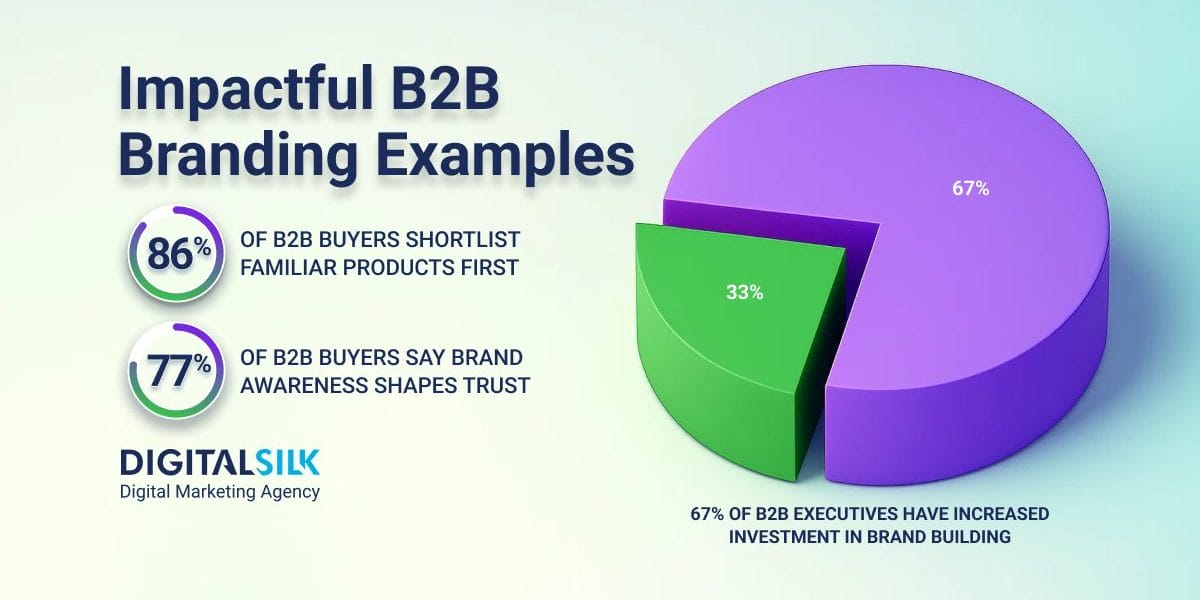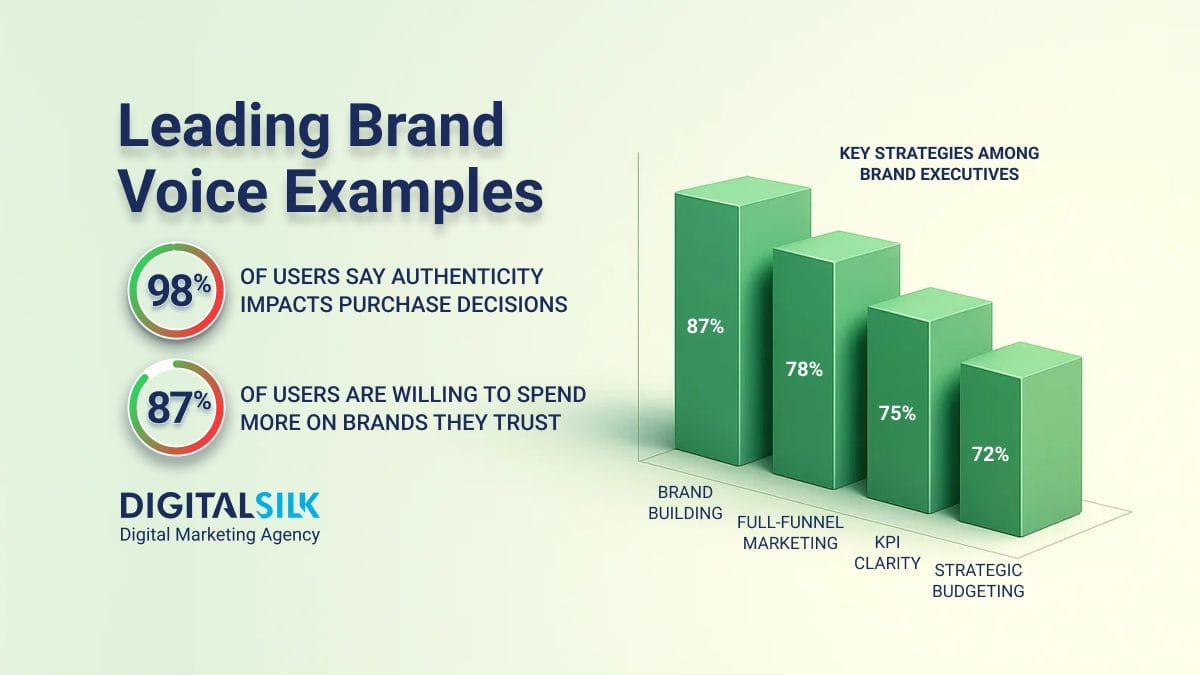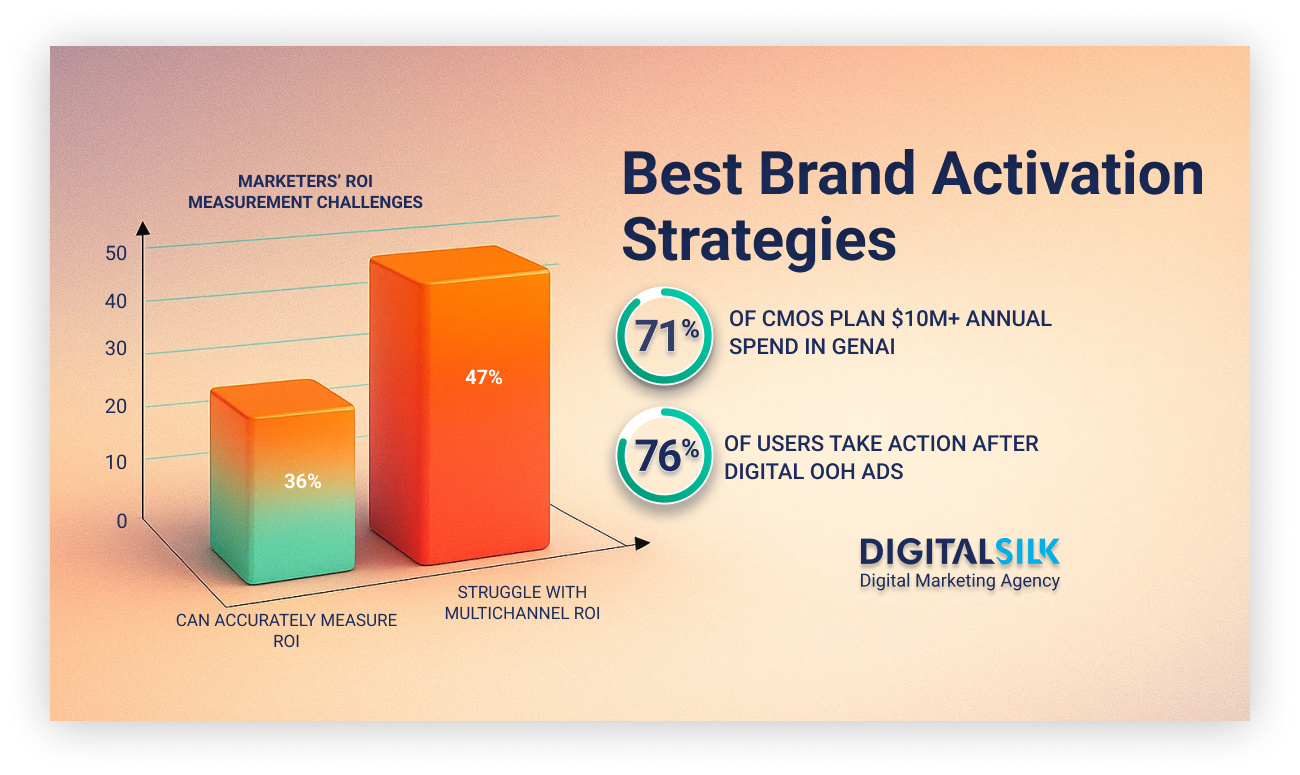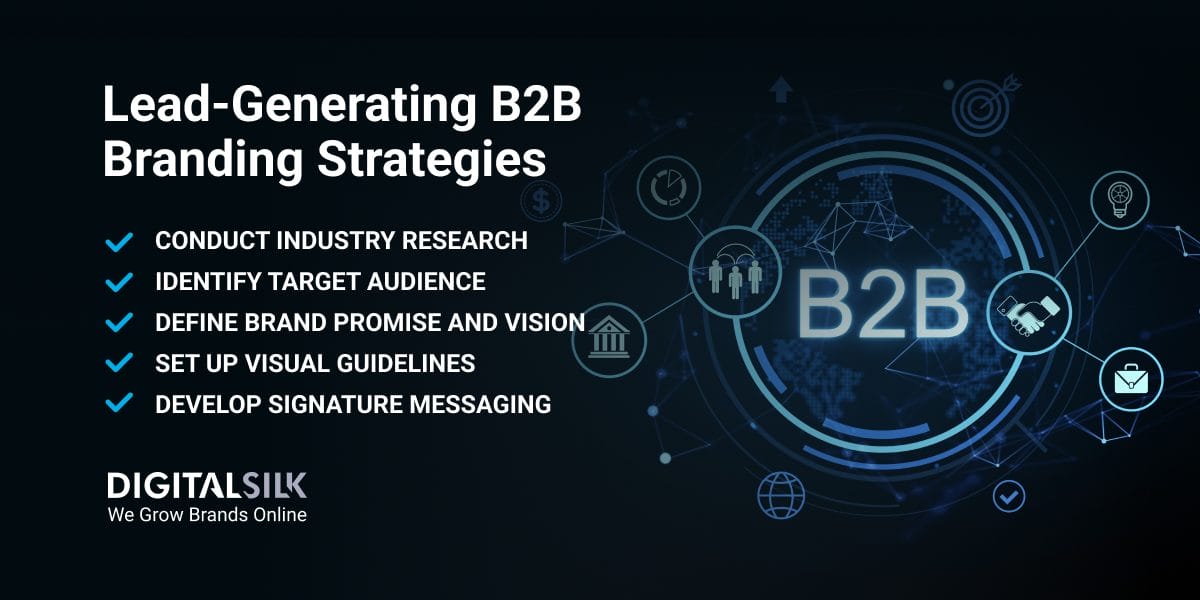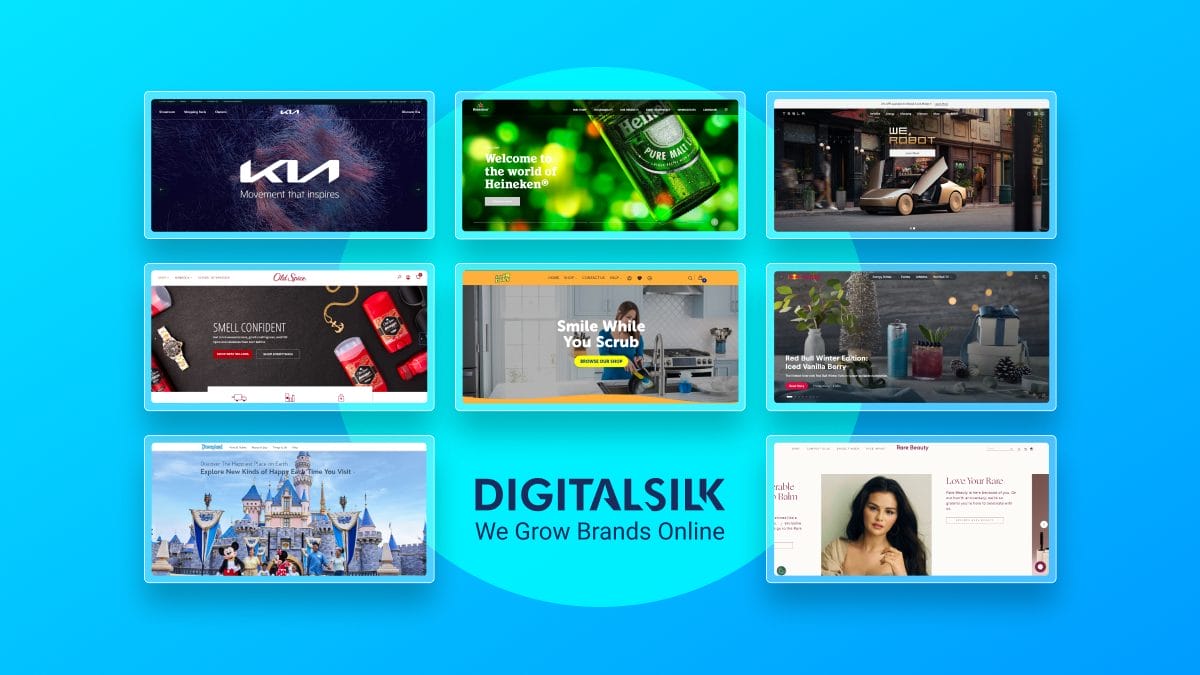B2B Branding Strategies: Key Highlights
-
Credibility is currency: B2B buyers shortlist brands they already trust, so every message must prove reliability before the first conversation.
-
Emotion reinforces trust: Professional buyers still respond to authenticity and shared values that make brands feel dependable.
-
Turn evidence into equity: Consistent proof from results, partnerships and validation turns performance into lasting value.
B2B companies face a paradox: buyers demand trust and credibility before they ever speak with sales, but too many brands blend into the background.
In fact, 77% of purchase influencers say brand awareness impacts their shortlist decisions, making it clear that branding drives revenue.
With U.S. B2B eCommerce sales forecasted to reach $3.12 trillion by 2027, the challenge is how to stand out from competitors.
This article showcases the best B2B branding examples, from tech giants to innovative challengers, and distils the strategies that transformed them into category leaders.
10 Innovative B2B Company Branding Strategies
B2B buyers go beyond merely weighing out product features, as they scrutinize whether a company has the required credibility and reliability for a long-term partnership.
Below, you’ll find 10 creative approaches to B2B branding that show how strong positioning turns visibility into revenue.
1. Adobe
Adobe is a great example of a brand that defined its category and kept expanding without losing its core identity.
Known worldwide as the standard for creative design, the company has extended that foundation into marketing automation, eCommerce and digital asset management.
Generating $21.50 billion in revenue in 2024, Adobe shows how a clear brand identity combined with steady innovation translates into market leadership and earns its place as one of the best B2B tech company branding examples to study closely.
Its real edge is building tools professionals trust while shaping how digital experiences work across industries.
Why This B2B Brand Strategy Works
- Category leadership: Adobe’s name is synonymous with creative software, so its tools often become the default choice in many industries.
- Expansion with purpose: Adding platforms like Marketo and Experience Cloud means Adobe serves as a full-service partner rather than a single-product company.
- Community and influence: Large gatherings such as Adobe Summit keep the brand at the center of industry conversations and close to practitioners.
- Global scale: Strong financials and a wide partner network signal reliability and support across markets.
2. Deliveroo
Deliveroo has established itself as one of the strongest brands in the food and drink B2B sector by positioning its platform as a partner to restaurants rather than simply a delivery service.
Deliveroo’s role stretches well past moving meals from point A to point B, as the company invests in programs that help restaurants grow their audience and stay visible in their neighborhoods.
“Editions”, for example, shines a light on local kitchens and puts them in front of nearby diners who might not have found them otherwise.
That kind of support gives partners exposure that is tough to earn alone, while at the same time casting Deliveroo as a practical engine for growth rather than a background logistics vendor.
The 2016 brand refresh, which introduced a simplified kangaroo logo, redesigned app and new rider uniforms, further reinforced the company’s identity as modern, recognizable and easy to trust at scale.
Why This B2B Brand Strategy Works
- Brand as infrastructure: Deliveroo’s model creates an ecosystem where restaurants can grow without heavy upfront investment.
- Scalable innovation: Concepts like “Editions” demonstrate how targeted programs can reshape entire categories, not just support individual partners.
- Memorable design: The updated logo and visual system strengthened recognition and helped unify the experience across digital and physical touchpoints.
- Dual impact: Deliveroo delivers value to both restaurants and end customers, sustaining loyalty on both sides of the market.
3. NVIDIA
NVIDIA reshaped how industries think about computing by turning the GPU into the backbone of modern innovation.
From AI infrastructure to autonomous vehicles and high-performance data centers, the company has positioned itself as the engine powering the next wave of technology.
Ranked as the second most valuable business and technology services brand with a valuation of $509.4 billion, NVIDIA demonstrates how relentless focus and credibility translate into extraordinary brand equity.
It stands out among the top B2B tech branding examples by showing how vision backed by execution can redefine entire markets.
Why This B2B Brand Strategy Works
- Clear positioning: NVIDIA is anchored in accelerated computing and AI, so it speaks with credibility across sectors while keeping a tight focus.
- Brand as platform: Events like the GPU Technology Conference bring developers, researchers and enterprise teams into direct contact with the brand, turning product news into real conversations.
- Leadership visibility: CEO Jensen Huang is recognized worldwide, and his regular presence on stage and in the media turns leadership into a concrete advantage for trust and influence.
- Strategic partnerships: Collaborations with major players from cloud providers to automotive innovators expand the company’s reach into diverse markets.
- Proof of scale: Global adoption of its hardware and systems reinforces trust at enterprise level.
4. Boston Consulting Group (BCG)
With 81% of B2B buyers expressing dissatisfaction with their chosen providers, BCG positions its brand around its expertise and buyer relationships that inspire long-term trust.
The firm points to its teams’ depth of skill and the results they deliver for industries and communities, while recognizing alumni who often step into top roles at major organizations.
This approach extends to clients as well, with the brand emphasizing collaboration and long-term partnerships as the foundation of its work.
By presenting its identity through both talent and proven capabilities, BCG communicates professionalism while staying approachable in a sector that can often feel abstract.
Why This B2B Brand Strategy Works
- People-driven branding: Showcasing consultants and alumni reinforces the brand as a network of expertise rather than a faceless firm.
- Trust through transparency: Sharing client stories and outcomes makes the brand feel accessible and credible.
- Thought leadership as identity: Published research, reports and usable industry frameworks extend the brand’s influence beyond active projects.
- Cultural alignment: Awards for workplace culture and visible values strengthen the brand’s image as principled and people-focused.
5. LinkedIn
Every major platform promises connection, but few deliver the kind of professional credibility that turns users into long-term members.
In the U.S., 76% of social media users recognize LinkedIn’s brand, proof that it has become synonymous with business networking.
Acquiring LinkedIn Learning and adding Sales Navigator expanded what members can do while keeping LinkedIn centered on one idea: a trusted place where professionals build relationships, share knowledge, and find opportunities.
By treating dependability as a core part of the brand, LinkedIn remains useful as hiring, networking and B2B selling change.
Why This B2B Brand Strategy Works
- Consistency as identity: Regular, predictable updates and steady core features build trust, especially compared with platforms that rewrite the rules every few months.
- Expanded ecosystem: Acquisitions and added products increase what members can do while keeping it all inside a place they already rely on.
- Professional alignment: Design, content guidelines and feature choices are built for work, which keeps the experience anchored in real business needs.
- Brand recognition: Strong name recognition and daily use mean professionals and companies often begin on LinkedIn when they want to reach each other
6. Bosch
Few companies carry the kind of brand familiarity that Bosch does in business markets.
When 86% of enterprise buyers short-list products they already know before beginning research, that recognition gives Bosch an advantage from the very start.
Its reputation for dependability extends beyond consumer goods into automotive systems, industrial robotics and advanced engineering, where performance and longevity define purchasing decisions.
As one of the most famous B2B tech branding examples, Bosch shows how decades of trust combined with visible innovation can keep a brand relevant across industries and generations.
Why This B2B Brand Strategy Works
- Recognition as an asset: Familiarity with the Bosch name builds trust early in the buying process.
- Cross-industry strength: From everyday consumer products to advanced industrial and automotive systems, the brand proves it can handle both simple and highly complex needs.
- Consistency of promise: Bosch is known for durability and precision, and it keeps that standard while continuing to introduce new technology.
- Modern communication: Campaigns use a contemporary, approachable voice that keeps the brand current in traditional B2B markets.
7. IBM
IBM is a long-standing name that keeps updating how it presents itself to match what businesses need now.
Its mix of software, hardware and consulting is tied together by a knack for explaining complex technology in plain, usable terms for enterprise users.
Partnerships with global players such as Microsoft, Salesforce and Adobe extend IBM’s influence and reinforce its reputation as a collaborator that drives outcomes at scale.
As one of the most successful B2B tech company branding examples, IBM shows how simplicity in communication and consistency in values can sustain authority across decades of change.
Why This B2B Brand Strategy Works
- Straightforward communication: IBM turns advanced technology into messaging that business leaders can quickly connect to outcomes.
- Breadth with focus: Bringing software, hardware and consulting under one roof gives customers one coherent brand to work with while keeping each offering clearly defined.
- Partnership branding: Working with leading companies through joint solutions, research, and cloud alliances keeps IBM relevant and shows customers its technology fits well alongside other major platforms.
- Values in action: Campaigns like #BeEqual connect the brand to social responsibility, reinforcing trust with clients and employees.
8. Deloitte
Deloitte holds its place among the Big Four accounting and professional services firms, but what distinguishes its brand is the way it projects authority through thought leadership as much as through client work.
Beyond providing audit, tax and advisory services, the firm produces a steady stream of research through Deloitte Insights, offering perspectives on industries from healthcare to technology that shape executive agendas.
This publishing engine turns Deloitte into more than a service provider, positioning it as a source of guidance for leaders who want to anticipate change rather than react to it.
The combination of client delivery, intellectual capital and visible commitment to workplace culture gives Deloitte a brand identity that feels both influential and human.
Why This B2B Brand Strategy Works
- Thought leadership as branding: Research and publications expand Deloitte’s visibility while reinforcing expertise across industries.
- Authority through influence: Executives use Deloitte’s research to frame decisions, set budgets and sequence initiatives, keeping the firm in real planning conversations.
- Employer reputation: Awards for workplace culture and career growth signal strong teams to clients and attract skilled candidates.
- Balance of scale and trust: Global presence is paired with a brand that emphasizes relationships and people.
9. DigitalOcean
DigitalOcean earned attention by making cloud infrastructure easier for developers and small businesses that lacked the time or resources to manage heavy enterprise platforms.
Its step-by-step tutorials, straightforward tools and active developer community created an environment where building applications feels accessible rather than intimidating.
Consistent branding, from the marine-inspired visuals to the shark mascot, reinforces recognition and gives the company a distinctive identity in a crowded sector.
DigitalOcean stands out among B2B tech companies with strong branding by showing how accessibility and community can turn a utility service into a trusted partner.
Why This B2B Brand Strategy Works
- Simplicity as a differentiator: The platform’s intuitive design lowers barriers for developers and businesses.
- Community focus: Events, initiatives and resources nurture a loyal developer base that advocates for the brand.
- Consistent identity: Visual elements like the marine theme and mascot create strong recognition across platforms.
- Value through content: Tutorials, case studies and guides position the brand as a trusted resource, not just a service provider.
10. SAP
SAP has become synonymous with enterprise software by showing how technology can scale with business needs over time.
From its beginnings in the 1970s to its current base of hundreds of millions of cloud users, the company has built trust by consistently adapting its offerings while keeping its identity anchored in reliability and integration.
Industry recognition from analysts reinforces the perception that SAP is a safe and forward-looking choice for global enterprises.
Its story illustrates how top B2B tech companies build their brand through a mix of heritage, adaptability and proof of value in complex environments.
Why This B2B Brand Strategy Works
- Heritage as credibility: Decades of running core systems for large organizations give SAP credibility that buyers can check and rely on.
- Innovation tied to brand: Shifting from installed software to cloud and practical AI shows SAP can adapt while staying focused on real business needs.
- Third-party validation: Consistent recognition from analysts strengthens its authority in competitive markets.
- Branding around integration: SAP positions itself as the platform that unifies business functions, reinforcing dependability.
Digital Silk’s Leading B2B Branding Case Studies
Digital Silk partners with brands across industries to craft strategies that strengthen recognition, trust and long-term value.
The following effective B2B branding case studies showcase how different organizations approached branding in unique ways to achieve growth:
1. VarData
Digital Silk helped VarData move from being perceived as a product-heavy reseller to a modern partner with a brand that reflects its two decades of expertise.

The rebrand included a refined identity system, consistent messaging and a lead-focused website that positioned the company as relationship-driven rather than transactional.
With this shift, VarData now stands among the best B2B tech company rebranding examples, showing how updated branding and digital structure can align perception with long-term growth.
The updated brand presence resonates with enterprise buyers, builds trust and creates a stronger foundation for scalable eCommerce and B2B engagement.
2. H2 Compliance
Digital Silk redefined H2 Compliance’s branding by creating a site that presented the company as a trusted authority across chemical, environmental and circular economy sectors.
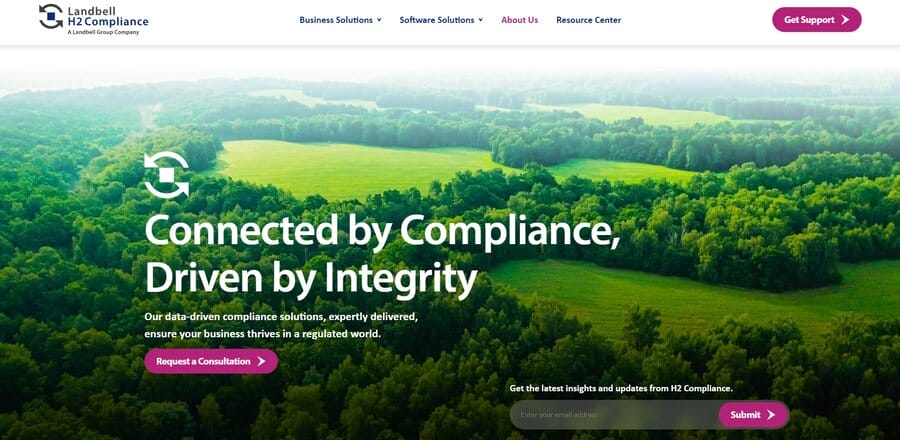
The new site established a clear brand narrative, replacing jargon with accessible messaging and visuals that projected professionalism and relevance.
Real photography and the interactive compliance map gave the brand a more authentic, differentiated presence.
This shift delivered a unified B2B identity that strengthens credibility and positions H2 Compliance for long-term market dominance.
What Makes A Winning B2B Brand
Building a strong B2B brand requires more than a memorable logo or a polished website.
Unlike B2C, where buying decisions are often fast and emotional, B2B decisions are high-stakes, involve multiple stakeholders and unfold over months of evaluation.
The most successful brands know how to reduce risk, project authority and inspire confidence long before sales conversations begin.
The Four Pillars of Effective B2B Branding
- Positioning with clarity: A winning B2B brand defines its space in the market with precision. It communicates not only what it does, but also why it matters to its audience. Clear positioning makes it easy for buyers to understand how the brand is different from competitors and why it is a safer or more innovative choice. Without clarity, brands risk blending into a sea of look-alike solutions.
- Consistency across touchpoints: Every interaction with a prospect should reinforce the same brand identity, whether it’s a sales presentation, a LinkedIn ad, or the onboarding experience. Consistency creates familiarity, which is critical in B2B where buying cycles are long and involve multiple departments. A cohesive voice and visual system reduce confusion and strengthen trust at every stage of the journey.
- Proof of reliability: B2B buyers look for tangible evidence that a brand can deliver. Case studies, third-party endorsements, analyst recognition, and strong partnerships act as validation points that replace face-to-face reassurance. These signals of credibility reassure buyers that choosing the brand will not put their career or business performance at risk.
- Emotional connection: Even in B2B, people don’t buy on logic alone. When investments are significant, buyers seek confidence that they are partnering with a brand they can rely on long term. Emotional cues such as trust, credibility or shared values, reduce perceived risk and strengthen loyalty. A brand that conveys authority and authenticity gives decision-makers confidence that they’re making the right choice.
Why B2B Branding Matters More Than Ever
The most impactful branding lessons come from seeing how leading companies earn trust, stand out and build loyalty over time.
Looking across the B2B branding examples shared above, clear patterns emerge that explain why branding has shifted from a marketing function to a driver of growth:
1. Establishes Credibility And Trust
B2B buyers dedicate just 17% of their evaluation time to direct meetings with suppliers, meaning the vast majority of their decisions are influenced by brand perception, peer discussions and independent research.
In that environment, branding is what determines whether your company is even considered before a call is scheduled.
A clear identity, supported by consistent messaging and visible proof points, gives buyers reasons to view the company as reliable.
Branding works as the reputation buyers rely on when you’re not in the room to speak for yourself.
2. Differentiates In Saturated Markets
Customer acquisition costs have risen 15–21% across industries in recent years, which makes every buyer interaction more costly and harder to win.
Branding helps companies cut through this friction by making their value clear before price or features even enter the conversation.
Instead of competing on features that blur together, companies with distinct branding shape the narrative of how they are compared.
3. Drives Long-Term Loyalty
67% of executives have increased investment in brand building, with 61% reporting that better creative work led to stronger engagement.
This reflects how branding fuels loyalty by reinforcing values and reliability over time.
Buyers who feel connected to a brand are more likely to return and recommend it, even when faced with lower-cost or similar alternatives.
Branding extends relationships beyond the transaction and builds long-term commitment.
4. Creates Resilience During Market Shifts
Periods of uncertainty expose the difference between providers that compete on transactions and those trusted as long-term partners.
When budgets get reduced, buyers are more likely to stay with brands they already associate with reliability and authority.
A recognizable brand preserves consideration even when spending slows, ensuring companies don’t lose visibility at critical moments.
This resilience helps firms maintain relationships through downturns and recover faster when conditions improve.
Create Effective B2B Branding With Digital Silk
Branding defines how companies earn trust, gain recognition and secure lasting relationships in competitive markets.
The patterns across leading B2B brands demonstrate how strategy and identity influence decisions well before buyers meet with a sales team.
Digital Silk‘s brand strategists work with companies across industries to create positioning, messaging and design systems that drive recognition and long-term growth.
As a professional branding agency, our services include:
Our team prioritizes proactive oversight and transparent communication so that every partnership drives measurable outcomes.
Contact our team, call us at (800) 206-9413 or fill in the Request a Quote form below to schedule a consultation.
"*" indicates required fields


